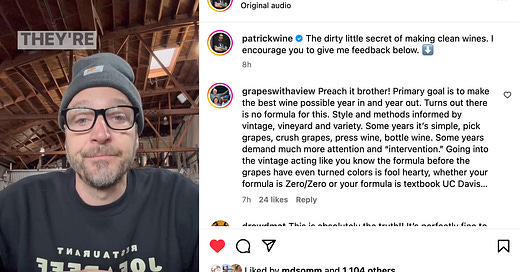Since launching this space last week, I’ve spent several days wondering how to dive in with content, hemming and hawing over “where to start.” There are so many case studies I want to follow, so many stories from makers I want to highlight, so many questions I want to ask. But if Resilient Wine is a movement dedicated to a more holistic, pragmatic, inclusive approach to wine making, buying and drinking, what introductions or explanations do I need to make before I get into the meat of the arguments? I’ve also been ruminating over how, as a retailer, hospitality person and educator, I have to admit that in reality I know so little about production, I’m sometimes embarrassed to admit I’ve gone along with an established rhetoric, nodding my head and then perpetuating the same conversation without asking, “But wait, why is that?” I’d hoped to outline this whole beautiful, thoughtful narrative about how I want this to be a space where it’s not just okay but actually essential to ask, “But wait… why?” I want this space to be one where we safely hear each other out, where we’re capable of nuance and healthy debate, where we’re respectful and transparent and authentic and do the whole “calling in, rather than calling out” thing. I felt like I needed to set up all these parameters, make all these introductions, write out all these ground rules before I really got started.
But conversations kept coming up this weekend that felt more urgent than outlining an entire thesis or approach. Maybe we just dive in—yesterday, rather than tomorrow! Don’t let perfect get in the way of good, you know? Anyway, a Substack really doesn’t need a formal starting place or chronology or narrative story arch. It’s really just a new format of a blog or a newsletter or a virtual magazine: an ongoing public discourse led by this author. If enough people find it interesting, they’ll jump in with wherever we’re at, and we won’t need to start from the beginning. So here we go. C’mon! Jump in! The water’s wine’s fine! Or wait—is it a little cloudy?
Such a tidy transition there, right, so that I can talk about filtration in wine?
So. I spent some time with Patrick Cappiello of Monte Rio Cellars this weekend. We drank sound wines, we drank flawed wines, we debated what it means for a wine to be “sound” (working conclusion: not so fucked up with volatile acidity and/or brettanomyces and/or mouse taint that you can’t smell or taste anything else), and we talked really honestly about Patrick’s winemaking and his prior ideals versus his current pragmatism. He asked if I’d make a wine with him, and I asked if he’d blurb my Resilient Wine book. Stay tuned.
More relevantly: Patrick told me he had been thinking for a while about transparency as a wine brand (or any brand for that matter), and I got VERY EXCITED because THISISWHATIMTALKINGABOUT here; this is a big part of why I started Resilient Wine. These are the honest conversations about choices we have to make as makers and owners that I know we have in our own private circles, and I’m arguing that we’re overdue for opening them up to the public. In particular, if we know that younger generations (who are purportedly, worrisomely, not drinking as much wine) care about brand values, ethics, transparency and authenticity, then brands need to open up these conversations—yesterday, not tomorrow. I am tired of believing that people won’t listen, don’t care, are too dumb or busy to actually understand nuanced perspectives. I believe people live up to the expectations you set for them, and maybe audiences seem too dumb or busy to understand because we’re not asking more of them.
Patrick told me that in his first vintages of winemaking for his Monte Rio Cellars label, he wasn’t fining or filtering, he wasn’t adding sulfur, he was idealistic… and, he said: “Those wines are undrinkable now.” Patrick has moved from being dogmatic into pragmatic. He’s moved into understanding that he also needs to sell wine and that his wines must be delicious in order to sell them. Uh-oh. Call the cops and get ready for a hullaballoo. Are you ready? He’s also moved into filtering his wines, which means passing it through a filter to remove fine particulate matter that could contain microbes that would ultimately spoil the wine. He’s moved into filtering his wines because they make them better and more transparent—not just free of visual turbidity, but figuratively transparent: more pure, more nuanced, more interesting, more complex, more delicious, more ageworthy.
And yet, Patrick was worried that he couldn’t tell his audience about this because a certain contingency of “gatekeepers” (sommeliers, wine retailers and salespeople) would exile him, would accuse him of being hypocritical as a “natural” winemaker. Natural winemakers DON’T FILTER! We asked: What is this about? And, “But wait, why? Why is filtering ‘bad’? Why is it shunned by the natural wine movement?”
If “natural” wine as a movement advocated for wellness for our human bodies and our planet, then tell us, what is harmful about filtering? There’s nothing harmful in a filter—neither to our bodies or our planet. So why is filtering wine—or event talking about it—so taboo that a thoughtful, intentional winemaker would be scared to tell people?
I don’t have an answer, but I hope this post and Patrick’s post today can help change that course. Patrick and his Monte Rio wines are fabulous and are precisely the resilient wine revelation the next generation of drinkers are ready for.




